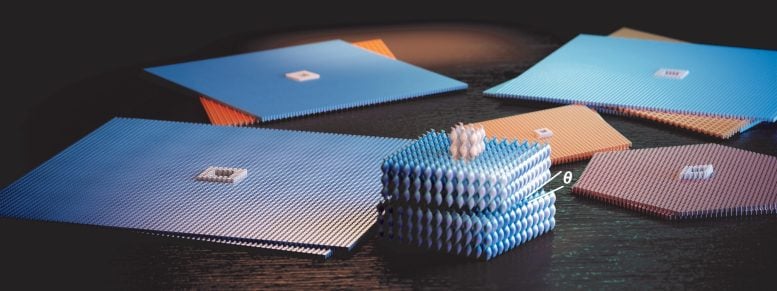
In a stunning leap forward, scientists have engineered <span class="glossaryLink" aria-describedby="tt" data-cmtooltip="
” data-gt-translate-attributes=”[{"attribute":"data-cmtooltip", "format":"html"}]” tabindex=”0″ role=”link”>DNA to act as a molecular architect, building intricate moiré superlattices with unprecedented control.
By programming twist angles and geometric patterns directly into DNA strands, researchers have created self-assembling nanostructures that could revolutionize everything from optics to quantum materials. These DNA-built lattices form on their own in solution, no manual stacking required, opening doors to materials that guide light, filter spin, or vibrate in precisely tuned ways — all at the <span class="glossaryLink" aria-describedby="tt" data-cmtooltip="
” data-gt-translate-attributes=”[{"attribute":"data-cmtooltip", "format":"html"}]” tabindex=”0″ role=”link”>nanoscale.
DNA-Based Design Revolutionizes Moiré Superlattices
Moiré superlattices are now a key focus in cutting-edge research across condensed matter physics and photonics. Yet building these structures usually requires a painstaking process, involving highly accurate layer alignment and transfer techniques performed under controlled laboratory conditions.
“Our approach bypasses traditional constraints of creating moiré superlattices,” says Prof. Laura Na Liu, director of the 2nd Physics Institute at the University of Stuttgart.
A Self-Assembling Blueprint for Nanoscale Structures
“Unlike conventional methods that rely on mechanical stacking and twisting of two-dimensional materials, our platform leverages a bottom-up assembly process,” explains Laura Na Liu. The assembly process refers to the linking of individual DNA strands to form larger, ordered structures. The process is guided by self-organization, meaning the DNA strands link together on their own through molecular interactions, without any outside intervention.
The Stuttgart team has built their method around this principle. “We encode the geometric parameters of the superlattice – such as rotation angle, sublattice spacing, and lattice symmetry – directly into the molecular design of the initial structure, known as the nucleation seed. We then allow the entire architecture to self-assemble with nanometer precision.”
This nucleation seed acts as a molecular instruction manual, guiding the growth of two-dimensional DNA lattices into carefully twisted bilayers or trilayers. The entire process takes place in a single step within a liquid solution, without the need for complex manipulation.

Unlocking the Intermediate Nanometer Realm
While moiré superlattices have been widely explored at the atomic (angstrom) and photonic (submicron) scales, the intermediate nanometer regime, where both molecular programmability and material functionality converge, has remained largely inaccessible. The Stuttgart researchers have closed this gap with their current study. The team combines two powerful DNA nanotechniques: DNA origami and single-stranded tile (SST) assembly.
Using this hybrid strategy, the researchers constructed micrometer-scale superlattices with unit cell dimensions as small as 2.2 nanometers, featuring tunable twist angles and various lattice symmetries, including square, kagome, and honeycomb. They also demonstrated gradient moiré superlattices, in which the twist angle and hence moiré periodicity varies continuously across the structure. “These superlattices reveal well-defined moiré patterns under transmission electron microscopy, with observed twist angles closely matching those encoded in the DNA origami seed,” notes co-author Prof. Peter A. van Aken from the Max Planck Institute for Solid State Research.
The study also introduces a new growth process for moiré superlattices. The process is initiated by spatially defined capture strands on the DNA seed that act as molecular ‘hooks’ to precisely bind SSTs and direct their interlayer alignment. This enables the controlled formation of twisted bilayers or trilayers with accurately aligned SST sublattices.
Powerful Applications from Optics to Spintronics
Their high spatial resolution, precise addressability, and programmable symmetry endow the new moiré superlattices with significant potential for diverse applications in research and technology. For example, they are ideal scaffolds for nanoscale components – such as fluorescent molecules, metallic nanoparticles or <span class="glossaryLink" aria-describedby="tt" data-cmtooltip="
” data-gt-translate-attributes=”[{"attribute":"data-cmtooltip", "format":"html"}]” tabindex=”0″ role=”link”>semiconductors in customized 2D and 3D architectures.
When chemically transformed into rigid frameworks, these lattices could be repurposed as phononic crystals or mechanical <span class="glossaryLink" aria-describedby="tt" data-cmtooltip="
” data-gt-translate-attributes=”[{"attribute":"data-cmtooltip", "format":"html"}]” tabindex=”0″ role=”link”>metamaterials with tunable vibrational responses. Their spatial gradient design also opens avenues for transformation optics and gradient-index photonic devices, where moiré periodicity could steer light or sound along controlled trajectories.
One particularly promising application lies in spin-selective electron transport. DNA has been shown to act as a spin filter, and these well-ordered superlattices with defined moiré symmetries could serve as a platform to explore topological spin transport phenomena in a highly programmable setting.
“This is not about mimicking quantum materials,” says Laura Na Liu. “It’s about expanding the design space and making it possible to build new types of structured matter from the bottom up, with geometric control embedded directly into the molecules.”
Reference: “DNA moiré superlattices” by Xinxin Jing, Nicolas Kroneberg, Andreas Peil, Benjamin Renz, Longjiang Ding, Tobias Heil, Katharina Hipp, Peter A. van Aken, Hao Yan and Na Liu, 17 July 2025, Nature Nanotechnology.
DOI: 10.1038/s41565-025-01976-3
Never miss a breakthrough: Join the SciTechDaily newsletter.
